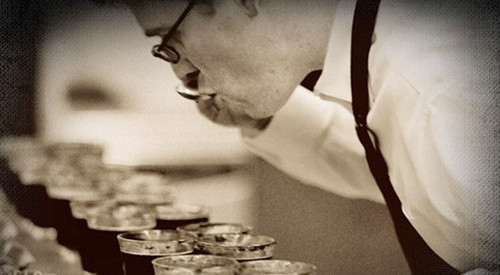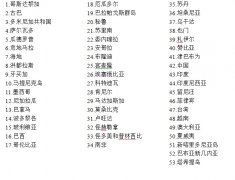The various parts of the coffee plant decompose the shallow root crop of coffee.

Coffea is a shallow root crop. Plants propagated from seeds have conical roots. Root system is the general term for roots. Root morphological distribution and depth vary with variety/soil conditions and agricultural techniques. The roots of small/medium seed are shallow, while those of large seed are deep. Under normal circumstances, there is a thick and short taproot and many developed lateral roots. Coffea arabica is a 3 - 4-year-old fruiting tree with a taproot depth of about 70 cm. Taproots beyond 70 cm tend to become slender and extend downward in the form of absorbing roots. Taproots generally do not bifurcate, but such as digging seedlings when injured, after planting from the wound healing down to grow one to two roots instead of broken taproots, lateral roots grow from the taproots, horizontal growth was called horizontal lateral roots, downward growth called vertical lateral roots, from the lateral roots were called secondary lateral roots, tertiary lateral roots. Coffee root system has obvious layered structure, generally every 5 cm for a layer, but most people absorb roots distributed in 0~30 cm soil layer, especially in the soil layer more than 15 cm, a small part of the distribution in 30~60 cm soil layer, 60 ~90 cm soil layer only a small number of absorbing roots, in the topsoil absorption roots thick and white, in 30 cm beyond the yellow and thin. The horizontal distribution of coffee roots was 15~20 cm beyond the canopy width in the juvenile stage, and staggered between rows in the adult stage. The roots were especially abundant in the topsoil of covered or shaded coffee plantations. The root system of coffee is strong in regeneration ability. It recovers quickly after being damaged or cut off. It grows healing tissue in 7 ~10 days, germinates many new lateral roots, and the new lateral roots grow out root rows for absorption. It is the most active root system.
2. stem
Coffee stems erect, tender stems slightly square, green, cork after a round, brown. Internodes 4 - 7 cm long, shaded and unshaded, overshaded internodes 20 - 30 cm long. Each node grows a pair of leaves, leaf axils have overlapping buds, called upper buds, called lower buds. The upper bud develops into a branch, and the lower bud develops into a straight branch. The upper node and terminal bud germinate simultaneously. Each upper bud sprouts only once, while the lower buds may sprout several times. When the terminal buds are inhibited or the trunk is bent, the buds germinate into straight shoots with trunk growth morphology, which can be cultured into trunks.
The growth of coffee stem has obvious apical dominance. Branches near the top of the trunk grow particularly vigorously. But this advantage decreases with the height of trunk. Its growth varies with species and natural climate characteristics. When the stem of Coffea arabica seedlings grows 6~9 pairs (8~12 pairs of medium seeds) of true leaves, the first pair of branches will be drawn. In the first year of planting, generally 4~8 pairs of one point grow, the growth of the second year gradually increased, generally 7~12 pairs, the third year can grow 14~15 pairs, if the management is good, the climate is suitable, up to 18~20 pairs, at the same time under the canopy grow two branches, open the platform to form a crown, and bear a small number of fruits, generally the third year after planting is the most vigorous growth/growth of the year, must strengthen management, especially the supply of water and fertilizer, to form a strong crown, In the fourth year, the growth of trunk slows down, internodes become shorter, and enter the fruiting period (there are also especially vigorous vegetative growth, a large number of branches in the second year, and the second or third year enters the fruiting period). If allowed to grow naturally, all types of coffee can continue to grow according to their growth capacity. Small seeds reach 4~6 m, medium seeds 6~8 m and large seeds more than 10 m. Harvesting is difficult, yield can be reduced, so stem height is controlled. Small-sized species were shaped into cylindrical crowns 3~4 years after planting by single stem shaping/topping.
The growth of trunk has seasonal change, dry season growth is small, internode is short, rainy season growth is large, internode is long, winter growth is minimum, internode is shortest, dense node appears. Therefore, according to this growth characteristic, we can know the plant age under natural growth.
Coffee branches are divided into the following categories according to their location and direction of growth:
One branch: coffee trunk leaf axils have upper/lower buds. From the trunk bud (and trunk terminal bud development at the same time) lateral out of the opposite branches, known as a branch.
Bibranched: Branches drawn from axils of a branch at an angle of 45 - 60 degrees are called bibranched, shorter than a branch.
Tribranched: Branches that regularly branch out from two-branched leaf axils are called tribranched.
Other branches at all levels are extrapolated accordingly. Coffea arabica var. yunnanensis has seven branches at most.
Secondary branches: Branches that grow irregularly into or under the crown on one or two branches.
Straight branches: the trunk of each section of the next bud is mostly in latent state, in the trunk terminal bud injury or growth is inhibited, in the short term, the next bud that sprouted, out of vertical upward long branches, said straight branches, some straight branches clustered in the shade of the canopy, was excessive long phenomenon, internodes are very long, so also known as excessive long branches. This kind of branch grows habit and trunk are similar, when much trunk is shaped, can use it to cultivate new trunk.
Coffee tree growth and fruiting varies with species/environmental conditions. Because of the cold climate, heavy cloud cover and short illumination, Coffea arabica grows slowly in high altitude areas of Yunnan Province, but the branches develop thick, and after one branch bears fruit, they develop into strong backbone branches, and the two/three branches have strong ability to grow, grow vigorously and bear dense fruits. It is the main bearing branch, so it is suitable to adopt single shaping. 2 - 3 years later, they die and germinate from the trunk branches.
The flowering and fruiting habits of a branch vary from month to month throughout the year.
The growth and fruiting habits of coffee 1/2 branches vary according to the type and flowering stage: 1 branch is divided into three types:
The first type: one branch sprouted from February to May every year, mainly for vegetative growth, the largest growth in the year, most of the next spring sprouted two branches, a strong branch in the year (July to September) sprouted two branches, individual branches in the next year can bear fruit. When a single integer is formed, select one branch of this type and cultivate the main branch.
The second type: a branch sprouting from June to September every year, and its reproductive and vegetative growth proceed simultaneously after sprouting. Therefore, the following year each branch can blossom and bear fruit, rarely give birth to two branches. A fruiting branch continues to grow, flowering in the third year, the main fruiting branch of the third year.
The third type is one branch sprouting after September. Because it enters the low temperature and drought period soon after sprouting, it grows slowly. The growth quantity is small in the current year, only 1~6 nodes, flowering and fruiting in the next year. The continuous growth part of the next year can sprout two branches. The growth and fruiting habits of two/three branches of small seeds are different from those of one branch. The climate is suitable, the management is normal, and it can be produced 2~3 times a year (February ~ March/May ~ June/August ~ September). The branches sprouted at the beginning of the year have a large growth and bear more fruits in the following year. But the following year continued to grow large, the third year a large number of results.
3. ye
Coffee leaves opposite, generally biseriate, individual single impeller, petiole short, leathery, green (upper surface dark green, lower surface pale green). Glossy oval, oval to oblong. Coffea arabica leaves are uniform in size, small and long at the tip, with obvious wavy edges, about 12~16 cm long and 5~7 cm wide. The leaves of medium-grain species are long and large, soft and thin, with obvious ripples, about 20~24 cm long and 8~10 cm wide. Large seed leaves leathery, hard thick, pointed, leaf margin nearly undulate, ca. 17 - 20 cm long, ca. 6 - 8 cm wide. Coffee tree leaves are typically ventral and dorsal symmetry. Leaves contain tannin, starch grains and calcium oxalate.
4. spend
Flowers several to dozens clustered in leaf axils, 2~5 per month on a flower axis, pedicel short, white, medium/small seed petals generally 5, 7~8 large seed, petal base connected into a tube, forming a high foot butterfly corolla, stamens generally the same number as petals, inserted in the throat of the corolla. anthers biculed on top of filaments, both forming a "D" shape, pistil style long filiform, stigma bifid, ovary hypogynous, usually biculular, also uniculular or trilocular. There is an anatropous ovule on the central placentation of each locule, with a very short funicle.
1. flower bud development characteristics
Flower bud development: coffee flower bud formation and varieties and environmental conditions have a close relationship, Franco (Franco) first pointed out, and confirmed by Piringer (Piringer) et al.: coffee (except perennial flowering mutation) is a short day plant. Under artificial light at night for more than 13 hours, plants only grow vegetatively. Mes found that temperature can affect coffee budding. At 23 ℃ in the day and 17 ℃ at night, the flower buds of plants were more than those at 26 ℃ in the day and 20 ℃ at night. At 30 ℃ in the day and 22 ℃ at night, the flower buds were poorly developed. Most axillary buds of annual branches of medium-seeded coffee did not develop or only a few flower buds developed and blossomed under sufficient sunshine.
The axillary buds of the same coffee at different stages need different time to develop into flowers, such as medium seed coffee, axillary buds sprouted before May need the longest time to develop into flowers (about 6~8 months), axillary buds sprouted in May ~ October need the middle time (about 4~5 months), axillary buds formed in October ~ November need the shortest time from the beginning to flower (3~4 months).
2. flowering characteristics
2.1 Coffee has the characteristics of multiple flowering, florescence and florescence concentration. The flower buds of coffee are multiple buds, each leaf axil has 2~6 flower buds, and the bud germination of one leaf axil (or flower buds of different plants) is inconsistent, some of them appear first and then form multiple flowering phenomenon, but there is a relative concentration period of flowering every year, that is, full florescence. The florescence of coffee varies with species and environmental conditions. The florescence of coffee is November ~ April in Hainan Island, and the full florescence is 2~ April. In Yunnan (Dehong Dai and Jingpo Autonomous Prefecture), the flowering period is from February to July, and the full flowering period is from March to May; in Guangxi, the flowering period is from February to June, and the full flowering period is from April to June.
2.2 The flowering of coffee is greatly affected by climate, especially rainfall and temperature. Under high temperature and drought, the buds of Coffea arabica developed normally, forming "star flower"/"melon flower." Under excessive drought, the buds of Coffea arabica were small, without flowering or bearing fruit after flowering. When the temperature is lower than 10 degrees Celsius buds do not open, temperature above 13 degrees Celsius is conducive to flowering.
2.3 Coffee flower life is short, only 2~3 days, Arabica flowers, generally in the morning at 3~5 o'clock, 5 ~7 o'clock blooming, stamen anther before blooming that a small number of pollen, to 9~10 o'clock or so, pollen sac completely split, a large number of pollen. The pollen of medium-grain species is more than that of small-grain species. Style and stamen mature differently in different coffee species. Stigma matures earlier than stamen in Coffea arabica. Stigma pollination ability is strongest on the day of flowering and the next day, then gradually lose its pollination ability, petals soon dry and wither. In flowering stage, if drought/wind or cold current occurs, the style is vulnerable to dryness, and if continuous rain occurs, the corolla is vulnerable to decay, which affects pollination/fruiting and yield.
5. fruit
Fruit for berries, also known as comb fruit. Elliptic, long 9~14 mm, green young fruit, mature red, purple. Each fruit generally has two seeds, also has one or three seeds, is semi-elliptical, has a longitudinal groove, called ventral groove. Fruit structure, exocarp by a thin layer of hard woody human cells, the outside scattered with stomata; mesocarp (i.e. pulp) is composed of several layers of polygonal large and lignified thin package, the most internal layers of cells were slightly compressed, cells can be seen containing a large number of fiber vascular bundles, endocarp also known as sheepskin (i.e. seed shell) is composed of stone cells a layer of cutin thin shell. Seed coat, also known as the silver skin, is the thin outer layer of the seed, seed coat color and thickness is one of the characteristics of the distinction between varieties, seed kernel, to remove the silver skin coffee beans, that is, the market called "commercial coffee beans," seeds containing two parts of the embryo, embryo at the base of the endosperm. The endosperm is dissected to reveal a white embryo with a pair of fleshy sunflower fan-shaped cotyledons.
1. fruit development
Coffee fruit development time is longer, the fruit from flowering to maturity time varies with species; small seed coffee needs 8~10 months (mature in October ~ December of the year); medium seed coffee needs 10~12 months (mature in November ~ May of the next year); large seed needs 12~13 months.
The fruit growth rate of Coffea arabica was the fastest 2~3 months after flowering. After 4 months, the fruit volume was basically stable and the dry matter accumulation increased. Dry matter increased fastest at 5~6 months after anthesis. The fruit development of medium seed coffee accelerated at 3~4 months after anthesis, fastest at 4 ~6 months, and slowed down at 7 ~9 months. At this time, dry matter accumulated rapidly in fruit, and its volume increased slightly before fruit ripeness.
2. Rainfall has a great influence on fruit development, and climate conditions directly affect fruit development.
A month after flowering, in case of drought, young fruit often dry due to lack of water, resulting in low fruit rate. Fruit development period drought fruit small/early, wind (or strong wind) is easy to cause fruit drop, resulting in yield or failure.
Important Notice :
前街咖啡 FrontStreet Coffee has moved to new addredd:
FrontStreet Coffee Address: 315,Donghua East Road,GuangZhou
Tel:020 38364473
- Prev

Distribution Map of Fine Coffee Bean growing countries in the World
- Next

Coffee trees are evergreen shrubs or trees belonging to Rubiaceae.
Coffee trees are evergreen shrubs or trees belonging to the Rubiaceae family. Wild coffee trees can grow to a height of 5 to 10 meters, but coffee trees planted in the manor are often cut to a height of less than 2 meters in order to increase fruit and facilitate harvesting. The opposite leaf of the coffee tree is long oval, the leaf surface is smooth, the end branch is very long, the branch is few, and the flower is white, opening at the base of the petiole connecting the branch.
Related
- Beginners will see the "Coffee pull flower" guide!
- What is the difference between ice blog purified milk and ordinary milk coffee?
- Why is the Philippines the largest producer of crops in Liberia?
- For coffee extraction, should the fine powder be retained?
- How does extracted espresso fill pressed powder? How much strength does it take to press the powder?
- How to make jasmine cold extract coffee? Is the jasmine + latte good?
- Will this little toy really make the coffee taste better? How does Lily Drip affect coffee extraction?
- Will the action of slapping the filter cup also affect coffee extraction?
- What's the difference between powder-to-water ratio and powder-to-liquid ratio?
- What is the Ethiopian local species? What does it have to do with Heirloom native species?

